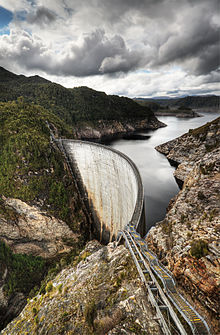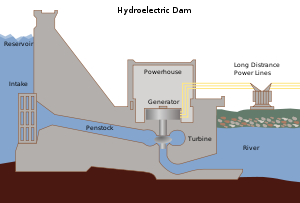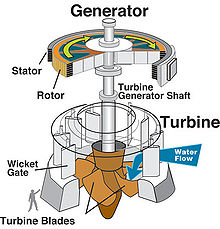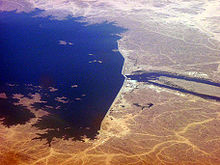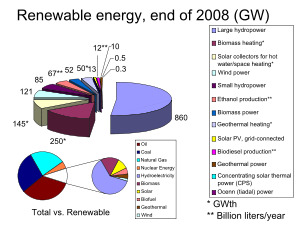- Hydroelectricity
-
Renewable energy Biofuel
Biomass
Geothermal
Hydroelectricity
Solar energy
Tidal power
Wave power
Wind powerHydroelectricity is the term referring to electricity generated by hydropower; the production of electrical power through the use of the gravitational force of falling or flowing water. It is the most widely used form of renewable energy. Once a hydroelectric complex is constructed, the project produces no direct waste, and has a considerably lower output level of the greenhouse gas carbon dioxide (CO2) than fossil fuel powered energy plants. Worldwide, an installed capacity of 1,010 GW supplied hydroelectricity in 2010. This was approximately 16% of the world's electricity, and accounted for about 76% of electricity from renewable sources.[1]
History
Hydropower has been used since ancient times to grind flour and perform other tasks. In the mid-1770s, French engineer Bernard Forest de Bélidor published Architecture Hydraulique which described vertical- and horizontal-axis hydraulic machines. By the late 19th century, the electrical generator was developed and could now be coupled with hydraulics.[2] The growing demand for the Industrial Revolution would drive development as well.[3] In 1878 the world's first hydroelectric power scheme was developed at Cragside in Northumberland, England by William George Armstrong. It was used to power a single arc lamp in his art gallery.[4] The old Schoelkopf Power Station No. 1 near Niagara Falls in the U.S. side began to produce electricity in 1881. The first Edison hydroelectric power plant, the Vulcan Street Plant, began operating September 30, 1882, in Appleton, Wisconsin, with an output of about 12.5 kilowatts.[5] By 1886 there were 45 hydroelectric power plants in the U.S. and Canada. By 1889 there were 200 in the U.S. alone.[2]
At the beginning of the 20th century, many small hydroelectric power plants were being constructed by commercial companies in mountains near metropolitan areas. Grenoble, France held the International Exhibition of Hydropower and Tourism with over one million visitors. By 1920 as 40% of the power produced in the United States was hydroelectric, the Federal Power Act was enacted into law. The Act created the Federal Power Commission to regulate hydroelectric power plants on federal land and water. As the power plants became larger, their associated dams developed additional purposes to include flood control, irrigation and navigation. Federal funding became necessary for large-scale development and federally owned corporations, such as the Tennessee Valley Authority (1933) and the Bonneville Power Administration (1937) were created.[3] Additionally, the Bureau of Reclamation which had began a series of western U.S. irrigation projects in the early 20th century was now constructing large hydroelectric projects such as the 1928 Hoover Dam.[6] The U.S. Army Corps of Engineers was also involved in hydroelectric development, completing the Bonneville Dam in 1937 and being recognized by the Flood Control Act of 1936 as the premier federal flood control agency.[7]
Hydroelectric power plants continued to become larger throughout the 20th century. Hydropower was referred to as white coal for its power and plenty.[8] Hoover Dam's initial 1,345 MW power plant was the world's largest hydroelectric power plant in 1936; it was eclipsed by the 6809 MW Grand Coulee Dam in 1942.[9] The Itaipu Dam opened in 1984 in South America as the largest, producing 14,000 MW but was surpassed in 2008 by the Three Gorges Dam in China at 22,500 MW. Hydroelectricity would eventually supply some countries, including Norway, Democratic Republic of the Congo, Paraguay and Brazil, with over 85% of their electricity. The United States currently has over 2,000 hydroelectric power plants which supply 49% of its renewable electricity.[3]
Generating methods
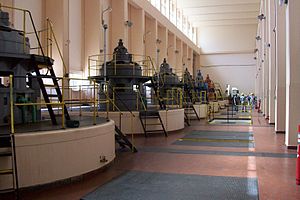 Turbine row at Los Nihuiles Power Station in Mendoza, Argentina
Turbine row at Los Nihuiles Power Station in Mendoza, Argentina
Conventional (dams)
See also: List of conventional hydroelectric power stationsMost hydroelectric power comes from the potential energy of dammed water driving a water turbine and generator. The power extracted from the water depends on the volume and on the difference in height between the source and the water's outflow. This height difference is called the head. The amount of potential energy in water is proportional to the head. A large pipe (the "penstock") delivers water to the turbine.
Pumped-storage
Main article: Pumped-storage hydroelectricitySee also: List of pumped-storage hydroelectric power stationsThis method produces electricity to supply high peak demands by moving water between reservoirs at different elevations. At times of low electrical demand, excess generation capacity is used to pump water into the higher reservoir. When there is higher demand, water is released back into the lower reservoir through a turbine. Pumped-storage schemes currently provide the most commercially important means of large-scale grid energy storage and improve the daily capacity factor of the generation system.
Run-of-the-river
Main article: Run-of-the-river hydroelectricitySee also: List of run-of-the-river hydroelectric power stationsRun-of-the-river hydroelectric stations are those with small or no reservoir capacity, so that the water coming from upstream must be used for generation at that moment, or must be allowed to bypass the dam.
Tide
Main article: Tide powerSee also: List of tidal power stationsA tidal power plant makes use of the daily rise and fall of ocean water due to tides; such sources are highly predictable, and if conditions permit construction of reservoirs, can also be dispatchable to generate power during high demand periods. Less common types of hydro schemes use water's kinetic energy or undammed sources such as undershot waterwheels.
Underground
Main article: Underground power stationAn underground power station makes use of a large natural height difference between two waterways, such as a waterfall or mountain lake. An underground tunnel is constructed to take water from the high reservoir to the generating hall built in an underground cavern near the lowest point of the water tunnel and a horizontal tailrace taking water away to the lower outlet waterway.
Sizes and capacities of hydroelectric facilities
Large and specialized industrial facilities
See also: List of largest power stations in the world and List of largest hydroelectric power stationsAlthough no official definition exists for the capacity range of large hydroelectric power stations, facilities from over a few hundred megawatts to more than 10 GW are generally considered large hydroelectric facilities. Currently, only three facilities over 10 GW (10,000 MW) are in operation worldwide; Three Gorges Dam at 22.5 GW, Itaipu Dam at 14 GW, and Guri Dam at 10.2 GW. Large-scale hydroelectric power stations are more commonly seen as the largest power producing facilities in the world, with some hydroelectric facilities capable of generating more than double the installed capacities of the current largest nuclear power stations.
While many hydroelectric projects supply public electricity networks, some are created to serve specific industrial enterprises. Dedicated hydroelectric projects are often built to provide the substantial amounts of electricity needed for aluminium electrolytic plants, for example. The Grand Coulee Dam switched to support Alcoa aluminium in Bellingham, Washington, United States for American World War II airplanes before it was allowed to provide irrigation and power to citizens (in addition to aluminium power) after the war. In Suriname, the Brokopondo Reservoir was constructed to provide electricity for the Alcoa aluminium industry. New Zealand's Manapouri Power Station was constructed to supply electricity to the aluminium smelter at Tiwai Point.
The construction of these large hydroelectric facilities, and their changes on the environment, are also often on grand scales, creating as much damage to the environment as at helps it by being a renewable resource. Many specialized organizations, such as the International Hydropower Association, look into these matters on a global scale.
Small
Main article: Small hydroSmall hydro is the development of hydroelectric power on a scale serving a small community or industrial plant. The definition of a small hydro project varies but a generating capacity of up to 10 megawatts (MW) is generally accepted as the upper limit of what can be termed small hydro. This may be stretched to 25 MW and 30 MW in Canada and the United States. Small-scale hydroelectricity production grew by 28% during 2008 from 2005, raising the total world small-hydro capacity to 85 GW. Over 70% of this was in China (65 GW), followed by Japan (3.5 GW), the United States (3 GW), and India (2 GW).[10]
 A micro-hydro facility in Vietnam
A micro-hydro facility in Vietnam
 Pico hydroelectricity in Mondulkiri, Cambodia
Pico hydroelectricity in Mondulkiri, Cambodia
Small hydro plants may be connected to conventional electrical distribution networks as a source of low-cost renewable energy. Alternatively, small hydro projects may be built in isolated areas that would be uneconomic to serve from a network, or in areas where there is no national electrical distribution network. Since small hydro projects usually have minimal reservoirs and civil construction work, they are seen as having a relatively low environmental impact compared to large hydro. This decreased environmental impact depends strongly on the balance between stream flow and power production.
Micro
Main article: Micro hydroMicro hydro is a term used for hydroelectric power installations that typically produce up to 100 KW of power. These installations can provide power to an isolated home or small community, or are sometimes connected to electric power networks. There are many of these installations around the world, particularly in developing nations as they can provide an economical source of energy without purchase of fuel.[11] Micro hydro systems complement photovoltaic solar energy systems because in many areas, water flow, and thus available hydro power, is highest in the winter when solar energy is at a minimum.
Pico
Main article: Pico hydroPico hydro is a term used for hydroelectric power generation of under 5 KW. It is useful in small, remote communities that require only a small amount of electricity. For example, to power one or two fluorescent light bulbs and a TV or radio for a few homes.[12] Even smaller turbines of 200-300W may power a single home in a developing country with a drop of only 1 m (3 ft). Pico-hydro setups typically are run-of-the-river, meaning that dams are not used, but rather pipes divert some of the flow, drop this down a gradient, and through the turbine before returning it to the stream.
Calculating the amount of available power
Main article: HydropowerA simple formula for approximating electric power production at a hydroelectric plant is: P = ρhrgk, where
- P is Power in watts,
- ρ is the density of water (~1000 kg/m3),
- h is height in meters,
- r is flow rate in cubic meters per second,
- g is acceleration due to gravity of 9.8 m/s2,
- k is a coefficient of efficiency ranging from 0 to 1. Efficiency is often higher (that is, closer to 1) with larger and more modern turbines.
Annual electric energy production depends on the available water supply. In some installations the water flow rate can vary by a factor of 10:1 over the course of a year.
Advantages and disadvantages of hydroelectricity
Advantages
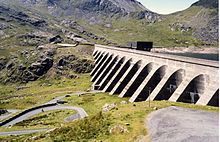 The Ffestiniog Power Station can generate 360 MW of electricity within 60 seconds of the demand arising.
The Ffestiniog Power Station can generate 360 MW of electricity within 60 seconds of the demand arising.
Economics
The major advantage of hydroelectricity is elimination of the cost of fuel. The cost of operating a hydroelectric plant is nearly immune to increases in the cost of fossil fuels such as oil, natural gas or coal, and no imports are needed.
Hydroelectric plants have long economic lives, with some plants still in service after 50–100 years.[13] Operating labor cost is also usually low, as plants are automated and have few personnel on site during normal operation.
Where a dam serves multiple purposes, a hydroelectric plant may be added with relatively low construction cost, providing a useful revenue stream to offset the costs of dam operation. It has been calculated that the sale of electricity from the Three Gorges Dam will cover the construction costs after 5 to 8 years of full generation.[14]
CO2 emissions
Since hydroelectric dams do not burn fossil fuels, they do not directly produce carbon dioxide. While some carbon dioxide is produced during manufacture and construction of the project, this is a tiny fraction of the operating emissions of equivalent fossil-fuel electricity generation. One measurement of greenhouse gas related and other externality comparison between energy sources can be found in the ExternE project by the Paul Scherrer Institut and the University of Stuttgart which was funded by the European Commission.[15] According to that study, hydroelectricity produces the least amount of greenhouse gases and externality of any energy source.[16] Coming in second place was wind, third was nuclear energy, and fourth was solar photovoltaic.[16] The extremely positive greenhouse gas impact of hydroelectricity is found especially in temperate climates. The above study was for local energy in Europe; presumably similar conditions prevail in North America and Northern Asia, which all see a regular, natural freeze/thaw cycle (with associated seasonal plant decay and regrowth).
Other uses of the reservoir
Reservoirs created by hydroelectric schemes often provide facilities for water sports, and become tourist attractions themselves. In some countries, aquaculture in reservoirs is common. Multi-use dams installed for irrigation support agriculture with a relatively constant water supply. Large hydro dams can control floods, which would otherwise affect people living downstream of the project.
Disadvantages
Ecosystem damage and loss of land
Large reservoirs required for the operation of hydroelectric power stations result in submersion of extensive areas upstream of the dams, destroying biologically rich and productive lowland and riverine valley forests, marshland and grasslands. The loss of land is often exacerbated by the fact that reservoirs cause habitat fragmentation of surrounding areas.
Hydroelectric projects can be disruptive to surrounding aquatic ecosystems both upstream and downstream of the plant site. For instance, studies have shown that dams along the Atlantic and Pacific coasts of North America have reduced salmon populations by preventing access to spawning grounds upstream, even though most dams in salmon habitat have fish ladders installed. Salmon spawn are also harmed on their migration to sea when they must pass through turbines. This has led to some areas transporting smolt downstream by barge during parts of the year. In some cases dams, such as the Marmot Dam, have been demolished due to the high impact on fish.[17] Turbine and power-plant designs that are easier on aquatic life are an active area of research. Mitigation measures such as fish ladders may be required at new projects or as a condition of re-licensing of existing projects.
Generation of hydroelectric power changes the downstream river environment. Water exiting a turbine usually contains very little suspended sediment, which can lead to scouring of river beds and loss of riverbanks.[18] Since turbine gates are often opened intermittently, rapid or even daily fluctuations in river flow are observed. For example, in the Grand Canyon, the daily cyclic flow variation caused by Glen Canyon Dam was found to be contributing to erosion of sand bars. Dissolved oxygen content of the water may change from pre-construction conditions. Depending on the location, water exiting from turbines is typically much warmer than the pre-dam water, which can change aquatic faunal populations, including endangered species, and prevent natural freezing processes from occurring. Some hydroelectric projects also use canals to divert a river at a shallower gradient to increase the head of the scheme. In some cases, the entire river may be diverted leaving a dry riverbed. Examples include the Tekapo and Pukaki Rivers in New Zealand.
Siltation
When water flows it has the ability to transport particles heavier than itself downstream. This has a negative effect on dams and subsequently their power stations, particularly those on rivers or within catchment areas with high siltation. Siltation can fill a reservoir and reduce its capacity to control floods along with causing additional horizontal pressure on the upstream portion of the dam. Eventually, some reservoirs can become completely full of sediment and useless or over-top during a flood and fail.[19][20] See Risks to the Glen Canyon Dam for a specific example.
Flow shortage
Changes in the amount of river flow will correlate with the amount of energy produced by a dam. Lower river flows because of drought, climate change or upstream dams and diversions will reduce the amount of live storage in a reservoir therefore reducing the amount of water that can be used for hydroelectricity. The result of diminished river flow can be power shortages in areas that depend heavily on hydroelectric power. The risk of flow shortage may increase as a result of climate change.[21] Studies from the Colorado River in the United States suggest that modest climate changes, such as an increase in temperature in 2 degree Celsius resulting in a 10% decline in precipitation, might reduce river run-off by up to 40%.[21] Brazil in particular is vulnerable due to its heaving reliance on hydroelectricity, as increasing temperatures, lower water flow and alterations in the rainfall regime, could reduce total energy production by 7% annually by the end of the century.[21]
Methane emissions (from reservoirs)
 The Hoover Dam in the United States is a large conventional dammed-hydro facility, with an installed capacity of 2,080 MW.
The Hoover Dam in the United States is a large conventional dammed-hydro facility, with an installed capacity of 2,080 MW. See also: Environmental impacts of reservoirs
See also: Environmental impacts of reservoirsLower positive impacts are found in the tropical regions, as it has been noted that the reservoirs of power plants in tropical regions may produce substantial amounts of methane. This is due to plant material in flooded areas decaying in an anaerobic environment, and forming methane, a potent greenhouse gas. According to the World Commission on Dams report,[22] where the reservoir is large compared to the generating capacity (less than 100 watts per square metre of surface area) and no clearing of the forests in the area was undertaken prior to impoundment of the reservoir, greenhouse gas emissions from the reservoir may be higher than those of a conventional oil-fired thermal generation plant.[23] Although these emissions represent carbon already in the biosphere, not fossil deposits that had been sequestered from the carbon cycle, there is a greater amount of methane due to anaerobic decay, causing greater damage than would otherwise have occurred had the forest decayed naturally.
In boreal reservoirs of Canada and Northern Europe, however, greenhouse gas emissions are typically only 2% to 8% of any kind of conventional fossil-fuel thermal generation. A new class of underwater logging operation that targets drowned forests can mitigate the effect of forest decay.[24]
In 2007, International Rivers accused hydropower firms of cheating with fake carbon credits under the Clean Development Mechanism, for hydropower projects already finished or under construction at the moment they applied to join the CDM. These carbon credits – of hydropower projects under the CDM in developing countries – can be sold to companies and governments in rich countries, in order to comply with the Kyoto protocol.[25]
Relocation
Another disadvantage of hydroelectric dams is the need to relocate the people living where the reservoirs are planned. In February 2008 it was estimated that 40-80 million people worldwide had been physically displaced as a direct result of dam construction.[26] In many cases, no amount of compensation can replace ancestral and cultural attachments to places that have spiritual value to the displaced population. Additionally, historically and culturally important sites can be flooded and lost.
Such problems have arisen at the Aswan Dam in Egypt between 1960 and 1980, the Three Gorges Dam in China, the Clyde Dam in New Zealand, and the Ilisu Dam in Turkey.
Failure hazard
Main article: Dam failureSee also: List of hydroelectric power station failuresBecause large conventional dammed-hydro facilities hold back large volumes of water, a failure due to poor construction, terrorism, or other cause can be catastrophic to downriver settlements and infrastructure. Dam failures have been some of the largest man-made disasters in history. Also, good design and construction are not an adequate guarantee of safety. Dams are tempting industrial targets for wartime attack, sabotage and terrorism, such as Operation Chastise in World War II.
The Banqiao Dam failure in Southern China directly resulted in the deaths of 26,000 people, and another 145,000 from epidemics. Millions were left homeless. Also, the creation of a dam in a geologically inappropriate location may cause disasters such as 1963 disaster at Vajont Dam in Italy, where almost 2000 people died.[27]
Smaller dams and micro hydro facilities create less risk, but can form continuing hazards even after being decommissioned. For example, the small Kelly Barnes Dam failed in 1967, causing 39 deaths with the Toccoa Flood, ten years after its power plant was decommissioned.[28]
Comparison with other methods of power generation
Hydroelectricity eliminates the flue gas emissions from fossil fuel combustion, including pollutants such as sulfur dioxide, nitric oxide, carbon monoxide, dust, and mercury in the coal. Hydroelectricity also avoids the hazards of coal mining and the indirect health effects of coal emissions. Compared to nuclear power, hydroelectricity generates no nuclear waste, has none of the dangers associated with uranium mining, nor nuclear leaks. Unlike uranium, hydroelectricity is also a renewable energy source.
Compared to wind farms, hydroelectricity power plants have a more predictable load factor. If the project has a storage reservoir, it can generate power when needed. Hydroelectric plants can be easily regulated to follow variations in power demand.
Unlike fossil-fuelled combustion turbines, construction of a hydroelectric plant requires a long lead-time for site studies, hydrological studies, and environmental impact assessment. Hydrological data up to 50 years or more is usually required to determine the best sites and operating regimes for a large hydroelectric plant. Unlike plants operated by fuel, such as fossil or nuclear energy, the number of sites that can be economically developed for hydroelectric production is limited; in many areas the most cost-effective sites have already been exploited. New hydro sites tend to be far from population centers and require extensive transmission lines. Hydroelectric generation depends on rainfall in the watershed, and may be significantly reduced in years of low rainfall or snowmelt. Long-term energy yield may be affected by climate change. Utilities that primarily use hydroelectric power may spend additional capital to build extra capacity to ensure sufficient power is available in low water years.
World hydroelectric capacity
See also: List of countries by electricity production from renewable sources and Cost of electricity by sourceThe ranking of hydro-electric capacity is either by actual annual energy production or by installed capacity power rating. A hydro-electric plant rarely operates at its full power rating over a full year; the ratio between annual average power and installed capacity rating is the capacity factor. The installed capacity is the sum of all generator nameplate power ratings. Sources came from BP Statistical Review - Full Report 2009[29]
Brazil, Canada, New Zealand, Norway, Paraguay, Austria, Switzerland, and Venezuela are the only countries in the world where the majority of the internal electric energy production is from hydroelectric power. Paraguay produces 100% of its electricity from hydroelectric dams, and exports 90% of its production to Brazil and to Argentina. Norway produces 98–99% of its electricity from hydroelectric sources.[30]
Ten of the largest hydroelectric producers as at 2009.[30][31] Country Annual hydroelectric
production (TWh)Installed
capacity (GW)Capacity
factor% of total
capacity China
China652.05 196.79 0.37 22.25  Canada
Canada369.5 88.974 0.59 61.12  Brazil
Brazil363.8 69.080 0.56 85.56  United States
United States250.6 79.511 0.42 5.74  Russia
Russia167.0 45.000 0.42 17.64  Norway
Norway140.5 27.528 0.49 98.25  India
India115.6 33.600 0.43 15.80  Venezuela
Venezuela85.96 14.622 0.67 69.20  Japan
Japan69.2 27.229 0.37 7.21  Sweden
Sweden65.5 16.209 0.46 44.34 Major projects under construction
Name Maximum Capacity Country Construction started Scheduled completion Comments Xiluodu Dam 12,600 MW China December 26, 2005 2015 Construction once stopped due to lack of environmental impact study. Belo Monte Dam 11,181 MW Brazil March, 2011 2015 Preliminary construction underway.[32] Siang Upper HE Project 11,000 MW India April, 2009 2024 Multi-phase construction over a period of 15 years. Construction was delayed due to dispute with China.[33] TaSang Dam 7,110 MW Burma March, 2007 2022 Controversial 228 meter tall dam with capacity to produce 35,446 Ghw annually. Xiangjiaba Dam 6,400 MW China November 26, 2006 2015 Nuozhadu Dam 5,850 MW China 2006 2017 Jinping 2 Hydropower Station 4,800 MW China January 30, 2007 2014 To build this dam, 23 families and 129 local residents need to be moved. It works with Jinping 1 Hydropower Station as a group. Jinping 1 Hydropower Station 3,600 MW China November 11, 2005 2014 Jirau Dam 3,300 MW Brazil 2008 2012 Construction halted in March 2011 due to worker riots.[34] Santo Antônio Dam 3,150 MW Brazil September 2008[35] 2011 Run-of-the-river project Pubugou Dam 3,300 MW China March 30, 2004 2010 Goupitan Dam 3,000 MW China November 8, 2003 2011 Guanyinyan Dam 3,000 MW China 2008 2015 Construction of the roads and spillway started. Lianghekou Dam[36] 3,000 MW China 2009 2015 Boguchan Dam 3,000 MW Russia 1980 2011 Dagangshan Dam 2,600 MW China August 15, 2008[37] 2014 Sơn La Dam 2,400 MW Vietnam December 2, 2005 2012 Guandi Dam 2,400 MW China November 11, 2007 2012 Liyuan Dam 2,400 MW China 2008[38] Tocoma Dam Bolívar State 2,160 MW Venezuela 2004 2014 This power plant would be the last development in the Low Caroni Basin, bringing the total to six power plants on the same river, including the 10,000MW Guri Dam.[39] Ludila Dam 2,100 MW China 2007 2015 Construction halt due to lack of the evnironmental assessment. Shuangjiangkou Dam 2,000 MW China December, 2007[40] The dam will be 312 m high. Ahai Dam 2,000 MW China July 27, 2006 Lower Subansiri Dam 2,000 MW India 2005 2012 See also
- Hydraulic engineering
- List of hydroelectric power stations
- List of hydroelectric power station failures
- Xcel Energy Cabin Creek Hydroelectric Plant Fire
References
- ^ Renewables 2011 Global Status Report, page 25, Hydropower, REN21, published 2011, accessed 2011-11-7.
- ^ a b "History of Hydropower". U.S. Department of Energy. http://www1.eere.energy.gov/windandhydro/hydro_history.html.
- ^ a b c "Hydroelectric Power". Water Encyclopedia. http://www.waterencyclopedia.com/Ge-Hy/Hydroelectric-Power.html.
- ^ Industrial archaeology review, Volumes 10-11. Oxford University Press. 1987. pp. 187. http://books.google.com/books?id=4xg9AQAAIAAJ&dq=Industrial%20archaeology%20review%3A%20Volumes%2010-11&source=gbs_book_other_versions.
- ^ "Hydroelectric power - energy from falling water". Clara.net. http://home.clara.net/darvill/altenerg/hydro.htm.
- ^ "Boulder Canyon Project Act". December 21, 1928. http://www.usbr.gov/lc/region/g1000/pdfiles/bcpact.pdf.
- ^ The Evolution of the Flood Control Act of 1936, Joseph L. Arnold, United States Army Corps of Engineers, 1988
- ^ The Book of Knowledge. Vol. 9 (1945 ed.). p. 3220.
- ^ "Hoover Dam and Lake Mead". U.S. Bureau of Reclamation. http://www.a2zlasvegas.com/otherside/sights/hoover.html.
- ^ Renewables Global Status Report 2006 Update, REN21, published 2006
- ^ Micro Hydro in the fight against poverty
- ^ "Pico Hydro Power". T4cd.org. http://www.t4cd.org/Resources/ICT_Resources/Projects/Pages/ICTProject_287.aspx. Retrieved 2010-07-16.
- ^ Hydropower – A Way of Becoming Independent of Fossil Energy?[dead link]
- ^ "Beyond Three Gorges in China". Waterpowermagazine.com. 2007-01-10. http://www.waterpowermagazine.com/story.asp?storyCode=2041318.
- ^ Rabl A. et. al. (August 2005). "Final Technical Report, Version 2". Externalities of Energy: Extension of Accounting Framework and Policy Applications. European Commission. http://www.externe.info/expoltec.pdf.
- ^ a b "External costs of electricity systems (graph format)". ExternE-Pol. Technology Assessment / GaBE (Paul Scherrer Institut). 2005. http://gabe.web.psi.ch/projects/externe_pol/index.html.
- ^ "Sandy River – Marmot Dam’s removal in 2007 has returned the Sandy River to a wild, free-flowing river". Portland General Electric. http://www.portlandgeneral.com/community_and_env/hydropower_and_fish/sandy/default.aspx.[dead link]
- ^ "Sedimentation Problems with Dams". Internationalrivers.org. http://internationalrivers.org/en/node/1476. Retrieved 2010-07-16.
- ^ Patrick James, H Chansen (1998). "Teaching Case Studies in Reservoir Siltation and Catchment Erosion". Great Britain: TEMPUS Publications. pp. 265–275. http://www.ijee.dit.ie/articles/Vol14-4/ijee1012.pdf.
- ^ Șentürk, Fuat (1994). Hydraulics of dams and reservoirs (reference. ed.). Highlands Ranch, Colo.: Water Resources Publications. p. 375. ISBN 0918334802.
- ^ a b c Frauke Urban and Tom Mitchell 2011. Climate change, disasters and electricity generation. London: Overseas Development Institute and Institute of Development Studies
- ^ "WCD Findal Report". Dams.org. 2000-11-16. http://www.dams.org/report/.
- ^ "Hydroelectric power's dirty secret revealed". Newscientist.com. http://www.newscientist.com/article.ns?id=dn7046.
- ^ ""Rediscovered" Wood & The Triton Sawfish". Inhabitat. 2006-11-16. http://inhabitat.com/2006/12/01/rediscovered-wood-the-triton-sawfish/#more-1973.
- ^ Nick Davies (3 December 2007). "Power firms accused of emissions trade cheating". London: The Guardian. http://www.guardian.co.uk/environment/2007/dec/03/climatechange.greenpolitics1.
- ^ "Briefing of World Commission on Dams". Internationalrivers.org. 2008-02-29. http://internationalrivers.org/en/way-forward/world-commission-dams/world-commission-dams-framework-brief-introduction.
- ^ References may be found in the list of Dam failures.
- ^ Toccoa Flood USGS Historical Site, retrieved 02sep2009
- ^ Consumption BP.com[dead link]
- ^ a b "Binge and purge". The Economist. 2009-01-22. http://www.economist.com/displaystory.cfm?story_id=12970769. Retrieved 2009-01-30. "98-99% of Norway’s electricity comes from hydroelectric plants."
- ^ "Indicators 2009, National Electric Power Industry". Chinese Government. http://www.sdpc.gov.cn/tztg/W020100106306926853623.doc. Retrieved 18 July 2010.
- ^ "Belo Monte hydroelectric dam construction work begins". Guardian UK. 10 March 2011. http://www.guardian.co.uk/environment/2011/mar/10/belo-monte-hydroelectric-work. Retrieved 2 April 2011.
- ^ Upper Siang project likely to be relocated on Chinese concerns
- ^ "Brazil Sends Forces to Jirau Dam After Riots". Wall Street Journal. 18 March 2011. http://online.wsj.com/article/SB10001424052748704608504576208640384691826.html. Retrieved 2 April 2011.
- ^ "How it all began" (in Portugese). Santo Antonio Builder Consortium LTD. http://www.uhesantoantonio.com/node/965. Retrieved 2 April 2011.
- ^ EHDC.com.cn
- ^ CB600.cn
- ^ ZT.xxgk.yn.cn
- ^ Staff (2004). "Caroní River Watershed Management Plan" (PDF). Inter-America Development Bank. http://idbgroup.org/exr/doc98/pro/pvel1003-06eng.pdf. Retrieved 2008-10-25.[dead link]
- ^ CJWSJY.com.cn
External links
- International Hydropower Association
- Hydroelectricity at the Open Directory Project
- National Hydropower Association, USA
- Hydropower Reform Coalition
- Interactive demonstration on the effects of dams on rivers
- International Rivers
- European Small Hydropower Association
Electricity generation Concepts Availability factor · Baseload · Black start · Capacity factor · Demand factor · Demand management · EROEI · Grid storage · Intermittency · Load following · Nameplate capacity · Peak demand · Repowering · Spark spreadSources Technology Distribution Policies Carbon offset · Coal phase out · Ecotax · Energy subsidies · Feed-in tariff · Net metering · Pigovian tax · Renewable Energy Certificates · Renewable energy payments · Renewable energy policyCategories: Electric power distribution · Electricity economics · Power station technology · Portals: Energy · Sustainable developmentTopics related to Hydropower Hydroelectricity · Head · Discharge · Dam · Francis turbine · Kaplan turbine · Tyson turbine · Gorlov helical turbine · Pelton wheel · Turgo turbine · Banki turbine · Conventional power stations · Big rivers · Pumped-storage · Run-of-the-river · Low head · Small hydro · Micro hydro · Pico hydroLists of countries by energy rankings Oil Natural gas Coal Nuclear power Renewable energy Electric energy Total energy Categories:- Hydroelectricity
- Landscape
- Sustainable technologies
Wikimedia Foundation. 2010.

